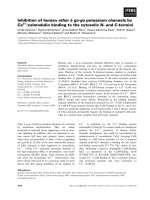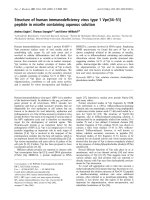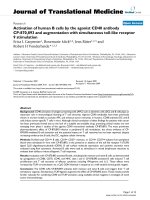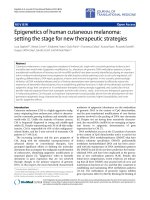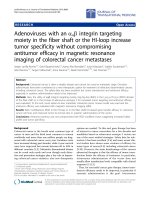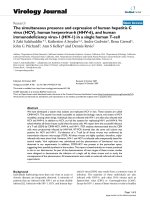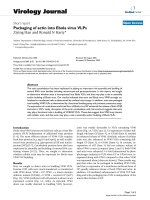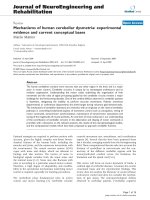Báo cáo hóa học: " Discovery of significant variants containing large deletions in the 5''''UTR of human hepatitis C virus (HCV)" pot
Bạn đang xem bản rút gọn của tài liệu. Xem và tải ngay bản đầy đủ của tài liệu tại đây (360.39 KB, 5 trang )
BioMed Central
Page 1 of 5
(page number not for citation purposes)
Virology Journal
Open Access
Research
Discovery of significant variants containing large deletions in the
5'UTR of human hepatitis C virus (HCV)
Dennis Revie
1
, Michael O Alberti
1
, Ravi S Braich
2,4
, David Bayles
2
,
John G Prichard
3
and S Zaki Salahuddin*
2
Address:
1
Department of Biology, California Lutheran University, Thousand Oaks, California, USA,
2
California Institute of Molecular Medicine,
Ventura, California, USA,
3
Ventura County Medical Center, Ventura, California, USA and
4
Alnylam Pharmaceuticals, Cambridge, Massachusetts,
USA
Email: Dennis Revie - ; Michael O Alberti - ; Ravi S Braich - ;
David Bayles - ; John G Prichard - ; S
Zaki Salahuddin* -
* Corresponding author
Abstract
We recently reported the isolation and in vitro replication of hepatitis C virus. These isolates were
termed CIMM-HCV and analyzed to establish genotypes and subtypes, which are reported
elsewhere. During this analysis, an HCV isolated from a patient was discovered that had large
deletions in the 5'UTR. 57% of the HCV RNA found in this patient's sera had 113 or 116 bp
deletions. Sequence data showed that domains IIIa to IIIc were missing. Previous studies have
suggested that these domains may be important for translation. In vitro replicated HCV from this
patient did not contain these deletions, however, it contained a 148 bp deletion in the 5'UTR.
Whereas the patient HCV lacked domains IIIa through IIIc, the isolate lacked domains IIIa through
IIId. HCV from this patient continues to produce large deletions in vitro, suggesting that the deletion
may not be important for the assembly or replication of the virus. This is the first report describing
these large deletions.
Background
HCV is a cause of several serious diseases, and is estimated
to infect around 3% of the world's population [1]. This
virus contains a 5'UTR, which is a conserved 341 nucle-
otide stretch. This region has been used to establish the
major HCV genotypes [2,3]. Other regions of the HCV
genome have been used to help determine subtypes.
Among the major genotypes, up to 30% of the sequences
of the major HCV strains can differ from each other [4].
Synthetic sequences called Replicons have been used to
study the functional aspects of the 5'UTR. This contains
the IRES region, which is important for the translation of
HCV RNA. Three domains: I, II, and III, are inside this
region. Domains I and II were shown to be important for
Replicon multiplication [5,6], and deletions of parts of
domain III can reduce the in vitro translation efficiency
[7]. Spahn et al. [8] used cryoelectron microscopy to show
that the 40S ribosomal subunit binds to domain III, and
the translation initiation factor eIF-3 binds to domain IIIb
[9]. A number of other proteins have been reported to
bind to the IRES, as well. This information has been
obtained using Replicons, which were developed by Bar-
tenschlager and his associates.
Published: 29 September 2006
Virology Journal 2006, 3:82 doi:10.1186/1743-422X-3-82
Received: 08 September 2006
Accepted: 29 September 2006
This article is available from: />© 2006 Revie et al; licensee BioMed Central Ltd.
This is an Open Access article distributed under the terms of the Creative Commons Attribution License ( />),
which permits unrestricted use, distribution, and reproduction in any medium, provided the original work is properly cited.
Virology Journal 2006, 3:82 />Page 2 of 5
(page number not for citation purposes)
We have developed an in vitro system that can isolate and
replicate HCV [10]. While studying HCV isolated by this
system, we discovered a patient that was missing part of
the 5'UTR. This report describes these large deletions.
Results
Patient 313 is a 51 year old woman with long-standing
HCV chronic-active hepatitis that developed porphyria
cutanea tarda which required intermittent phlebotomy
for symptomatic relief and prevention. Otherwise, she
was in good health and had not undergone liver biopsy
procedure or any HCV treatment before the blood sample
was obtained. There was no history of hepatitis B virus or
HIV-1 infection. Phlebotomy was performed by standard
techniques using transfusion donor bags containing
sodium heparin. We received this anti-coagulated sample
for use in HCV investigations.
Gel electrophoresis of RT-PCR fragments of the 5'UTR for
patient 313 showed two bands on agarose gels instead of
the single band that is normally observed (Figure 1, Lane
1). To determine why there were two bands, we cloned
and sequenced the PCR fragments (Table 1).
Analysis of HCV sequences from patient 313 showed that
57% of the clones contained either a 113 or a 116 bp dele-
tion (Figure 1, Lane 1). The deleted regions extended from
either bases 126 or 129 to 241. The deletions of 113 or
116 bp were limited to the region between two strings of
C's, with 56% of the sequences containing deletions lack-
ing 113 bp and 44% lacking 116 bp. Most of the IRES,
including loops IIIa, IIIb, and IIIc, was missing (Figure 2).
The consensus sequence of the 313 plasma HCV that con-
tained the deletions was the same as the consensus
sequence for the full length 313 plasma HCV, except for
the deletion.
The HCV was isolated from the patient in the usual man-
ner as was reported before [11]. The HCV produced by
macrophages is called the primary isolate and is desig-
nated 313-i. A cell-free supernatant of this isolate is then
used to infect Epstein-Barr virus transformed B-cells. The
HCV produced by B-cells is the secondary isolate, and des-
ignated 313-T1.
We found no deletions in the primary isolate 313-i (Figure
1, Lane 2). There were no deletions in the first 313-T1
sample analyzed (Figure 1, Lane 3), but 6 clones had dele-
tions in 313-T1b (19%). 313-T1 was isolated on 10/18/04
and 313-T1b was isolated on 2/24/05, so 313-T1b was
grown in culture four months longer than 313-T1. This
deletion extends from bases 141 to 288, and is therefore a
different deletion than the one found in the patient's
blood (Figure 2).
We also noted that each of the 313 samples had at least
one clone that contained an extra C in the string of C's
from bases 120 to 126. Other isolates from different
patients sometimes also contain an extra C in this region
[11].
Discussion
We have previously reported the isolation of HCV from
infected patients and in vitro replication of these isolates
[10]. A molecular analysis of CIMM-HCV for possible
subtypes and quasispecies was recently performed which
showed that the isolated HCV had only minor sequence
changes compared to patient HCV [11].
A patient with unique deletions is the subject of this study.
This patient had not yet undergone therapy, and therefore
the deletions found in the patient were not induced by
treatment. Deletions of up to 18 bases in the 5'UTR, along
with additions of up to 40 bases have previously been
reported [12], and deletions of up to 2 kb have been
found in the protein coding region of HCV [13]. The dele-
Analysis of deletions found in patient 313 sera and CIMM-HCV isolatesFigure 1
Analysis of deletions found in patient 313 sera and
CIMM-HCV isolates. Agarose gel electrophoresis of
RT-PCR products of HCV RNA isolated from plasma
and in vitro cultures. A 100 bp ladder was used (NE
Biolabs). Lane 1 is 313 plasma, lane 2 is 313-i, lane 3 is 313-
T1. The 269 bp fragment contains the 5'UTR. The approxi-
mately 150 bp fragments observed in 313 plasma were
shown by sequencing to contain large deletions of the 5'UTR.
400
300
200
100
base
pairs
Ladder 1 2 3
Virology Journal 2006, 3:82 />Page 3 of 5
(page number not for citation purposes)
Table 1: List of CIMM-HCV isolates cloned and sequenced
Isolate Number of clones sequenced Genbank accession numbers Description
313 plasma 60 EF028185 Patient sample
313-i 26 EF028184
Primary isolate in macrophages
313-T1 26 EF028187
Secondary isolate in B-cells
313-T1b 32 EF028188
Secondary isolate, cultured 4
months longer
Map of deletions found in 313 plasma and 313T1Figure 2
Map of deletions found in 313 plasma and 313T1. A 2D map of the 313 plasma consensus sequence is shown. The
extents of the large deletions found in 313 plasma are shown by the outlining. The inset shows the extent of the large deletions
found in 313-T1b. This figure is adapted from Lyons et al. [23]. The 5'UTR sequences of the samples containing deletions have
the accession numbers EF028186
, EF028194, and EF028189.
Virology Journal 2006, 3:82 />Page 4 of 5
(page number not for citation purposes)
tions of 113 or 116 bp in patient 313 were limited to the
region between two strings of C's in the 5'UTR. Domains
IIIa through IIIc, which are missing in these deletions, are
thought to be bound by the right leg of eIF3 [14]. Otto et
al. [15] crosslinked a IIIa to IIIc domain deletion named
del_IIIabc to the 40S ribosomal subunit. Del_IIIabc,
which lacks bases 152 to 240, crosslinked to the small
ribosomal subunit proteins to about the same extent as
did the wild-type IRES. This suggests that the deletion
found in patient 313 would probably bind to the 40S sub-
unit. An alternative mechanism of initiation of translation
in high MgCl
2
was recently reported for HCV [16]. This
pathway does not require eIF3 or other known translation
initiation factors. It may be that the deletions we are
reporting cause this alternate method of initiation to be
used. Although deletions in domain III may adversely
affect the translation of HCV RNA, they do not appear to
affect HCV replication. This may be because only domains
I and II are needed for this purpose [6]. It is possible that
the deletions of stem loops in domain III may reduce in
vitro translation [6,7,17-22]. It is also possible that wild
type 313 HCV without the deletion is infectious, but in
the process of replication produces a large amount of
defective, non-infectious virus particles.
Although the 113 or 116 bp deletions were found in
patient 313's blood, the primary isolate, 313-i, did not
contain these deletions. This may be due to selection by
the macrophages. The deletion that we found in 313-T1b
appears to have occurred during the culturing, as the size
of 148 bp and its location in the 5'UTR are not the same
as those found in the patient's blood. Since the 148 bp
region lacks domains IIIa to IIId, it is unlikely to be effi-
ciently used for translation. Only the 313 isolate and not
isolates from other patients produced the deleted version
in vitro. A mutation in the polymerase gene could decrease
fidelity or processivity. Sequencing the entire genome of
both the 313-T1 and the HCV found in the patient's blood
may be helpful in understanding this phenomenon.
Papers that have reported HCV sequences often analyze
the hyper-variable region, therefore, they would have not
detected these deletions. Other researchers have used one
or both PCR primers that are either inside or overlap the
region of the deletion, so they also would have not been
detected. For this study, we cloned the entire PCR reac-
tions to ensure that all possible HCV sequences were
detected.
The presence of an extra C in the 5'UTR region was found
in the HCV RNA from the 313 plasma sample and for
313T1 and three isolates from patient 081 [11]. Plasma
from patient 313 contains the extra C, which could cause
the HCV RNA polymerase to accidentally create the
deleted versions of the 5'UTR. However, of our isolates
containing the extra C's, only 313T1 had variants with
large deletions, but that particular deletion was not
located adjacent to that extra C. Others have reported the
effects on translation of particular regions of the 5' and 3'
ends of the 5'UTR containing deletions [17,18]. These and
other reports, however, do not cover the same regions as
we have noted here.
These isolates of HCV containing large deletions should
prove useful in understanding translation of HCV RNA.
Methods
The in vitro culture system, RT-PCR, sequencing, and bio-
informatics were performed as described in Revie et al.
[11]. The 313 isolates have the GenBank accession num-
bers of EF028185
, EF028184, EF028187, and EF028188.
Declaration of competing interests
All intellectual rights are reserved by the California Insti-
tute of Molecular Medicine (CIMM), and all aspects of
this work were performed by CIMM. There are no compet-
ing interests between California Lutheran University or
any other body and CIMM.
Authors' contributions
SZS performed the biological work and the isolations,
transmissions, and retransmissions of HCV. JGP per-
formed the clinical work, recruitment of patients, and pro-
curement of specimens. DR, MOA, RSB, and DB
performed the molecular work.
Acknowledgements
The California Institute of Molecular Medicine would like to thank Dr
Cheryl Geer of the Center for Women's Well Being, Camarillo, California,
USA, Dr Ann S. Kelley of the Ventura County Hematology-Oncology Spe-
cialists, Oxnard, California, USA, Dr. Terry L. Cole of Community Memo-
rial Hospital, Ventura, CA, Drs. Rosemary McIntyre and Parsa of
Hematology & Oncology Specialists of Oxnard, Ventura, CA, and the staff
of Hematology & Oncology Specialists, Ventura, CA for their continued
efforts and support in our efforts to advance HCV research.
References
1. WHO: Hepatitis C – global prevalence (update). Weekly Epide-
miological Record 1999, 49:425-427.
2. Simmonds P: Genetic diversity and evolution of hepatitis C
virus 15 years on. J Gen Virol 2004, 85:3173-3188.
3. Kato N: Genome of human hepatitis C virus (HCV): gene
organization, sequence diversity, and variation. Microb Comp
Genomics 2000, 5:129-151.
4. Rosenberg S: Recent advances in the molecular biology of hep-
atitis C virus. J Mol Biol 2001, 313:451-464.
5. Lohmann V, Korner F, Koch J, Herian U, Theilmann L, Bartenschlager
R: Replication of subgenomic hepatitis C virus RNAs in a
hepatoma cell line. Science 1999, 285:110-113.
6. Kim YK, Kim CS, Lee SH, Jang SK: Domains I and II in the 5’ non-
translated region of the HCV genome are required for RNA
replication. Biochem Biophys Res Commun 2002, 290:105-112.
7. Otto GA, Puglisi JD: The pathway of HCV IRES-mediated
translation initiation. Cell 2004, 119:369-380.
8. Spahn CM, Kieft JS, Grassucci RA, Penczek PA, Zhou K, Doudna JA,
Frank J: Hepatitis C virus IRES RNA-induced changes in the
conformation of the 40s ribosomal subunit. Science 2001,
291:1959-1962.
Publish with BioMed Central and every
scientist can read your work free of charge
"BioMed Central will be the most significant development for
disseminating the results of biomedical research in our lifetime."
Sir Paul Nurse, Cancer Research UK
Your research papers will be:
available free of charge to the entire biomedical community
peer reviewed and published immediately upon acceptance
cited in PubMed and archived on PubMed Central
yours — you keep the copyright
Submit your manuscript here:
/>BioMedcentral
Virology Journal 2006, 3:82 />Page 5 of 5
(page number not for citation purposes)
9. Kieft JS, Zhou K, Jubin R, Doudna JA: Mechanism of ribosome
recruitment by hepatitis C IRES RNA. RNA 2001, 7:194-206.
10. Revie D, Braich RS, Bayles D, Chelyapov N, Khan R, Geer C, Reisman
R, Kelley AS, Prichard JG, Salahuddin SZ: Transmission of human
hepatitis C virus from patients in secondary cells for long
term culture. Virol J 2005, 2:37.
11. Revie D, Alberti MO, Braich RS, Chelyapov N, Bayles D, Prichard JG,
Salahuddin SZ: Analysis of in vitro replicated human hepatitis
C virus (HCV) for the determination of genotypes and qua-
sispecies. Virol J 2006, 3:81.
12. Chen YD, Liu MY, Yu WL, Li JQ, Peng M, Dai Q, Wu J, Liu X, Zhou
ZQ: Sequence variability of the 5' UTR in isolates of hepatitis
C virus in China. Hepatobiliary Pancreat Dis Int 2002, 1:541-552.
13. Yagi S, Mori K, Tanaka E, Matsumoto A, Sunaga F, Kiyosawa K,
Yamaguchi K: Identification of novel HCV subgenome replicat-
ing persistently in chronic active hepatitis C patients. J Med
Virol 2005, 77:399-413.
14. Siridechadilok B, Fraser CS, Hall RJ, Doudna JA, Nogales E: Struc-
tural roles for human translation factor eIF3 in initiation of
protein synthesis. Science 2005, 310:1513-1515.
15. Otto GA, Lukavsky PJ, Lancaster AM, Sarnow P, Puglisi JD: Ribos-
omal proteins mediate the hepatitis C virus IRES-HeLa 40S
interaction. RNA 2002, 8:913-923.
16. Lancaster AM, Jan E, Sarnow P: Initiation factor-independent
translation mediated by the hepatitis C virus internal ribos-
ome entry site. RNA 2006, 12(5):894-902.
17. Wang C, Sarnow P, Siddiqui A: Translation of human hepatitis C
virus RNA in cultured cells is mediated by an internal ribos-
ome-binding mechanism. J Virol 1993, 67:3338-3344.
18. Wang C, Sarnow P, Siddiqui A: A conserved helical element is
essential for internal initiation of translation of hepatitis C
virus RNA. J Virol 1994, 68:
7301-7307.
19. Jubin R, Vantuno NE, Kieft JS, Murray MG, Doudna JA, Lau JY,
Baroudy BM: Hepatitis C virus internal ribosome entry site
(IRES) stem loop IIId contains a phylogenetically conserved
GGG triplet essential for translation and IRES folding. J Virol
2000, 74:10430-10437.
20. Rijnbrand RCA, Lemon SM: Internal Ribosome Entry Site-Medi-
ated Translation in Hepatitis C Virus Replication. Current Top-
ics in Microbiology and Immunology 2000, 242:85-116.
21. Qi ZT, Kalkeri G, Hanible J, Prabhu R, Bastian F, Garry RF, Dash S:
Stem-loop structures II-IV of the 5’ untranslated sequences
are required for the expression of the full-length hepatitis C
virus genome. Arch Virol 2003, 148:449-467.
22. Ji H, Fraser CS, Yu Y, Leary J, Doudna JA: Coordinated assembly
of human translation initiation complexes by the hepatitis C
virus internal ribosome entry site RNA. Proc Natl Acad Sci U S
A 2004, 101:16990-16995.
23. Lyons AJ, Lytle JR, Gomez J, Robertson HD: Hepatitis C virus
internal ribosome entry site RNA contains a tertiary struc-
tural element in a functional domain of stem-loop II. Nucleic
Acids Res 2001, 29:2535-2541.
